Continuation Patterns: Key Takeaways
- Why new traders with small accounts should learn continuation patterns…
- How to build a solid trading plan using these patterns…
- 4 top patterns to learn from today — with chart examples…
Apply for my Trading Challenge today!
Patterns are everywhere in life — and they can help you in your trading in a big way. Find out what you need to know about continuation patterns and learn four every trader should know. Read on!
Table of Contents
- 1 What Are Continuation Patterns?
- 2 4 Continuation Patterns Every Trader Should Know
- 3 Key Tips for Your Continuation Patterns Trading Plan
- 4 Continuation Patterns for Forex and Stocks Trading: Are They the Same?
- 5 Continuation Patterns: Frequently Asked Questions
- 6 What Are Reversal Patterns?
- 7 What Are Bearish Continuation Patterns?
- 8 What Are Bullish Continuation Patterns?
- 9 What Are Trend Continuation Patterns?
- 10 How Long Do Patterns Usually Last?
- 11 The Bottom Line
- 12 Disclaimers
What Are Continuation Patterns?

2025 Millionaire Media, LLCAs a day trader, I rely on technical analysis most. I look for support and resistance, breakouts, and morning panics. You can see all of that on a stock’s chart.
And continuation patterns are part of that.
A continuation pattern is when a price action trend is broken by a consolidation period and then resumes again. During the consolidation period, the trained trader can spot common patterns on the chart. You can learn to see these patterns too.
But why does the price go through a period of consolidation? Usually, supply and demand — or traders taking profits or cutting losses. That causes most market fluctuations.
Let’s say a BIG catalyst sparks a clean spike for a stock…
At some point during the spike, some traders will close their positions to take profits. So you might get a selling period, where the stock’s price drops a bit.
Then, some traders buy back in. They believe the stock will keep moving in the trending direction. So the next candle is an upward price trend.
A consolidation period can last anywhere from minutes to weeks. The price tends to stay within a range during that time — and form one of the patterns I’ll show you in a bit.
After the consolidation period, the trend continues in its original direction … at least, in theory.
Benefits of Using Continuation Patterns
Why do these patterns matter? They can give you an idea of a stock’s future price action.
It’s not an exact science. Consolidation periods don’t always turn into continuation patterns. There are reversal patterns, too.
Rules can help. And as long as you stick to the rules and your trading plan, you’ll be better prepared for whatever the market throws your way.
4 Continuation Patterns Every Trader Should Know

2025 Millionaire Media, LLCLet’s check out the top continuation patterns traders use.
Keep in mind that I trade and teach day trading, so these examples are based on shorter time frames. But you could see these patterns in longer-term charts (like a one-year chart with daily candles), as well.
The point is to learn to recognize the patterns, plan around them, and use them to your advantage.
Also, I recommend using candlestick charts. They can show you so much information fast. They also make it easier to spot continuation patterns.
#1 Rectangles
Rectangles form when the trend —up or down — stops temporarily.
Price action consolidates within parallel support and resistance lines. Then, after the period of consolidation, the trend continues in its original direction.
Example of a Rectangle Continuation Pattern
Look at the chart for AMC Entertainment Holdings (NYSE: AMC). I know I said that I’d mostly share short-term charts, but this is a great example.
If you look at the initial spike, you see it started to fade before hitting a consolidation period, which is rectangle-shaped. The consolidation period lasted for several months before the price broke out again and shot up.
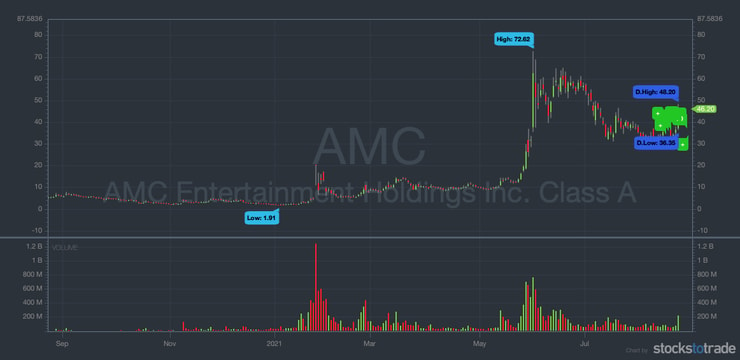
More Breaking News
- BigBear.ai Faces Legal Storm: What’s Next?
- Surviving Trump’s Trade War: Top Penny Stocks to Watch Now
- Gelteq’s Surprising Performance: A Stock Gaining Momentum?
#2 Wedges
The wedge pattern can be difficult to see on a candlestick chart, but it becomes easier with practice and experience.
Look for a flat support line on one side of the wedge. Depending on whether it’s bullish or bearish, the opposing support or resistance line approaches the flat line at an angle.
Example of a Wedge Continuation Pattern
Check out the chart for Kaixin Auto Holdings (NASDAQ: KXIN). If you look at the initial spike on August 5, you’ll see a few spikes that consolidated then pushed higher.
Some of those initial consolidation periods were wedge-shaped. They had a flat resistance level on top and a curved support level on the bottom.
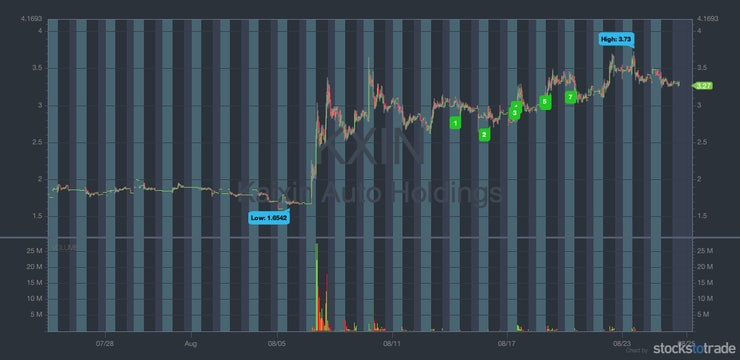
#3 Flags
Flags are pretty easy to see — the initial price movement, aka flagpole, is steep. A flag follows the flagpole and usually slopes in the opposite direction. After the flag, the trend continues.
Another thing you might notice with this pattern … The price action on the breakout or breakdown after the flag is similar in range to the movement before the flag.
For example, if the flagpole is a rise of 20 cents per share, then after the consolidation, you could expect another movement of roughly 20 cents.
This can give you an idea of possible entry and exit points. It helps you plan your trade and know where to cut losses quickly if the trade goes bad.
Example of a Flag Continuation Pattern
Look at the chart for Sonnet BioTherapeutics Holdings (NASDAQ: SONN). This is a great example of a flag pattern. This time, look at the downtrend…
After this stock spiked big early in the day, it started fading hard. Soon after, it gapped down big, consolidated, and gapped down big again. The stock ended lower than where it started before the big jump.
The great thing about this example is that both gap downs were similar in size. That’s a classic sign of a flag continuation pattern.
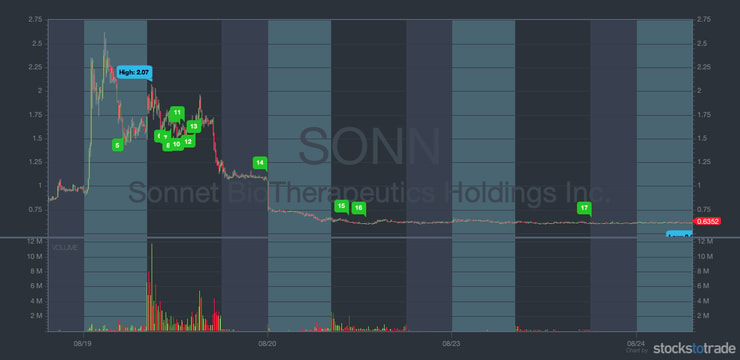
#4 Triangles
There are a few varieties of triangle shape patterns. The triangle can be symmetric or asymmetric. It can be sloping up or down depending on the trend.
Sometimes triangle patterns are also called pennants.
Example of a Triangle Continuation Pattern
Check out the Support.com (NASDAQ: SPRT) chart below. The upward trend is broken by the triangle-shaped consolidation. The key here is that the highs and lows begin to converge.
I know. The consolidation period wasn’t exactly at the highs during the initial uptrend, but that’s OK. Patterns are rarely picture-perfect. Learn to spot the imperfect ones, too.
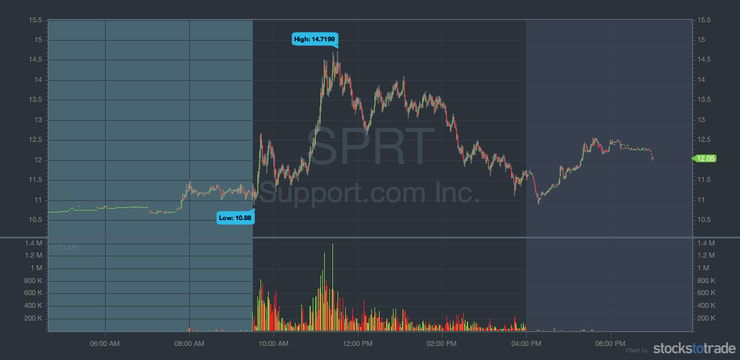
Key Tips for Your Continuation Patterns Trading Plan
First, continuation patterns trade in a similar manner. They all have consolidation periods that interrupt the price trend.
Also, the shapes aren’t always perfect. So don’t force a trade if the shape looks off. It might not be a continuation.
At the same time, you don’t have to wait for the perfect symmetrical triangle or rectangle. You might wait forever. Try to understand the psychology of what’s happening — the opposing buy and sell forces at play.
Once the consolidation period happens, look for confirmation of the trend’s continuation.
Remember that every trading plan must include entry and exit points, a stop loss, your trade thesis, a potential catalyst, and more.
Tim Grittani is one of the best penny stock traders and started his journey in my Trading Challenge.* He has pages of spreadsheets detailing every trade he’s made. That’s one reason for Grittaini’s trading success. He makes plans and sticks to them.
Remember Small Gains Add Up
No need to trade big to build your brokerage account. In fact, you shouldn’t try to trade big until you have a lot of experience. Would you try to learn anything else in life by going big right from the start?
That just increases your risk. Work on small gains and even smaller losses.
This is what I love about penny stocks. You can grow your small account with small positions over time — if you know how to make good trades.
As you do that, your experience adds up. Then you can consider larger positions.
Don’t Trust Promoters
Never trust promoters. They don’t have your best interest at heart. They promote stocks so the price will go up, then dump their positions to take profits.
Most traders fail. One reason for that is because too many newbies fall for promoter hype. Ride the hype but NEVER believe it.
Trade With the Right Knowledge
Too many newbies blow up their accounts because they have no idea what they’re doing. It happens over and over. Stop. Focus on your education and study.
Do you want to learn to recognize and trade continuation patterns? Work at it!
Again, the vast majority of traders lose. My rules and patterns can help change that because I teach my students to think differently. I’ve been profitable pretty much every year since I started day trading.* Sure, I have losses (who doesn’t?), but I keep them small.
The lesson is to always gain knowledge first.
Practice First
Why would you trade with your hard-earned cash without practicing first? No, trading isn’t rocket science. It’s a learnable set of skills and knowledge. But it takes practice, effort, and dedication.
StocksToTrade is a trading platform I helped design, and it has paper trading capabilities.** So you can practice trading the exact patterns I trade until you’re ready for the real thing.
Once you’ve got it down to where you’re winning more than half the time, you can give live trading a shot. It’s how you can practice identifying continuation patterns and so much more.
Check out StocksToTrade for 14 days — it’s just $7.
Continuation Patterns for Forex and Stocks Trading: Are They the Same?

2025 Millionaire Media, LLCForex and stocks can have a lot of similar patterns. But I don’t trade forex. It’s too volatile for me. Even though I trade sketchy penny stocks, I’m a conservative trader. I stick with these stocks because they’re what I’m comfortable with.
Continuation Patterns: Frequently Asked Questions
What Are Reversal Patterns?
Reversal patterns signal a change in a trend. These patterns show that the buyers or short sellers have run out of momentum. When there’s a consolidation period followed by a change in the trend, it’s a reversal pattern.
What Are Bearish Continuation Patterns?
These patterns have consolidation periods that form in the middle of a continuing downtrend. Once the consolidation period ends, the price trend continues its downward bearish move.
What Are Bullish Continuation Patterns?
This is the opposite of bearish. With these patterns, the consolidation periods form in the middle of a continuing uptrend. Then, the price trend continues upward.
What Are Trend Continuation Patterns?
Trend continuation patterns are trends broken up by consolidation periods. Then the trend continues again in its initial direction.
How Long Do Patterns Usually Last?
There isn’t a simple answer to this. Patterns can last anywhere from minutes to years. I trade patterns that come and go in a matter of days, but that doesn’t mean you can’t trade patterns that take longer to form. Find what works for you.
The Bottom Line

2025 Millionaire Media, LLCLearning to recognize continuation patterns is crucial to your trading foundation. Take the four patterns we talked about today and go find some examples. They don’t have to be perfect, but you need to be able to see them pretty clearly.
Start building your foundation now. Here are a few things to do every day starting today: Build a watchlist, make a trading plan, keep a trading journal, and look for patterns.
How do you use continuation patterns in your trading? Leave a comment below!
Disclaimers
*Results are not typical and will vary from person to person. Making money trading stocks takes time, dedication, and hard work. Most who receive free or paid content will make little or no money because they will not apply the skills being taught. Any results displayed are exceptional. We do not guarantee any outcome regarding your earnings or income as the factors that impact such results are numerous and uncontrollable.
It takes years of hard work, dedication, and discipline to learn how to trade. Individual results will vary. Trading is inherently risky. Before making any trades, remember to do your due diligence and never risk more than you can afford to lose. I’ve also hired Tim Grittani to help in my education business.
**Tim Sykes has a minority ownership stake in StocksToTrade.com.




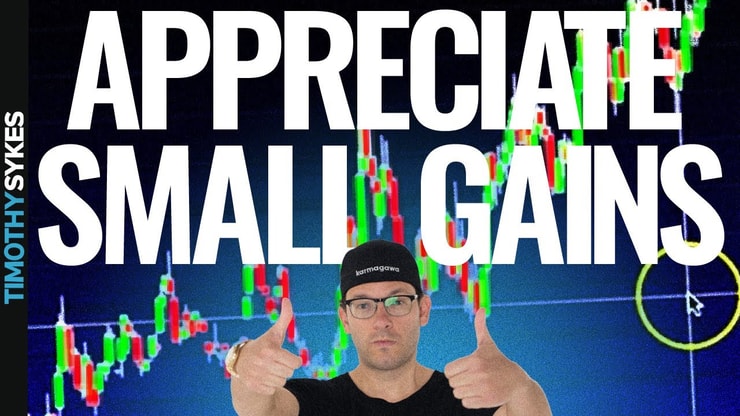







Leave a reply